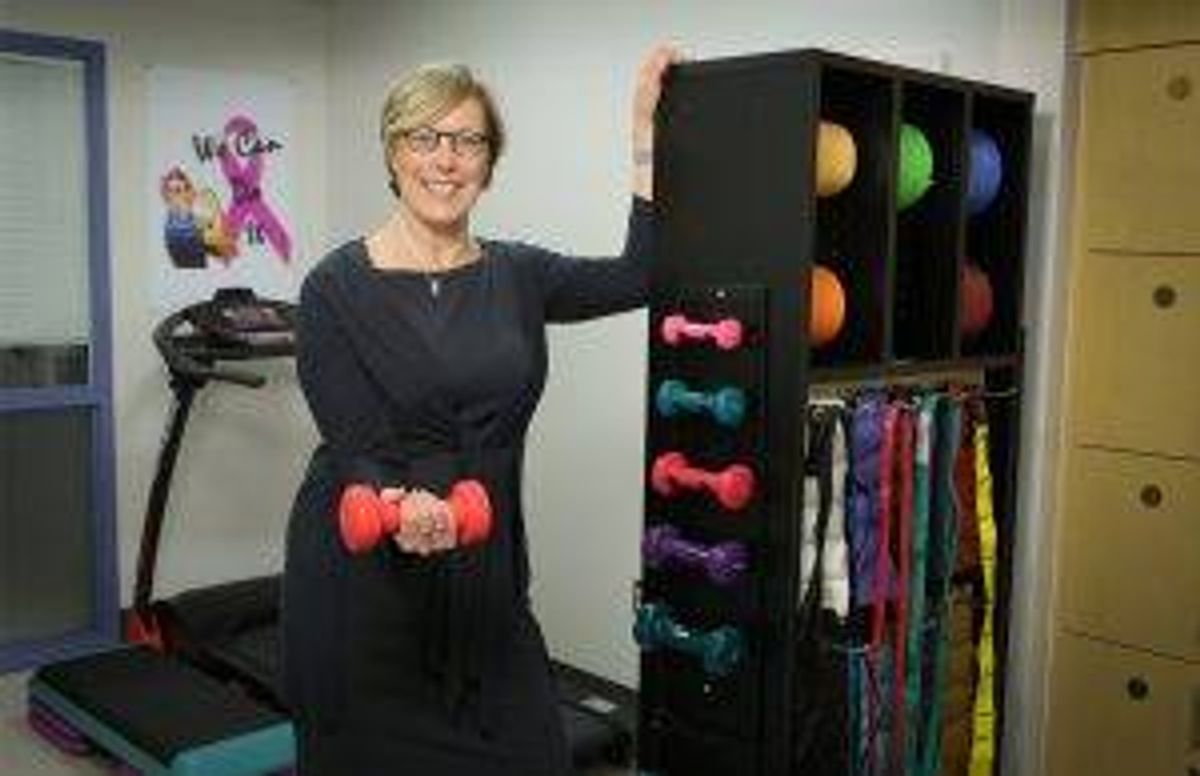Keep Moving, Even Through Cancer Treatment
Experts say exercise improves outcomes for cancer patients
Maureen Salloum of Queens, N.Y., has always been a busy person, raising her two children, working as a school counselor and getting out to enjoy cultural activities. But other than the occasional bicycle ride, she had never been much into sports or working out at a gym.

Then in 2011, at 49, Salloum was diagnosed with stage 3C ovarian cancer, and had three recurrences.
In 2013, still dealing with the cancer, Salloum found an unusual group activity that has increased her stamina, endurance and balance, as well as greatly enhanced the quality of her life: She joined the Empire Dragons NYC, one of 150 dragon boat teams worldwide for breast cancer survivors -- although there are some other cancer survivors as well. The program promotes the paddling sport for a healthy lifestyle and emotional support and camaraderie.

Participating on the team has been “one of the most wonderful surprises of my cancer journey,” Salloum says. The program includes racing during the summer months and team meetings and twice-weekly boot camps off season.
“The high I get from the racing, and the emotional support and camaraderie that I get from women who are literally ‘in the same boat’ as I am, has made all the difference in the world,” Salloum says.
A New Mantra: Avoid Inactivity
It might seem counterintuitive to encourage a cancer survivor or a person in the midst of cancer treatment to exercise. But that way of thinking needs to change, says Kathryn Schmitz, professor of public health sciences at the Penn State College of Medicine in Hershey, Pa.
"We know for certain that exercise extends life and improves functionality, both in healthy people and in those living with illness."
“We need a paradigm shift so that both oncologists and the public begin to disregard what many have been taught, which is that people with cancer shouldn’t push themselves and that getting enough rest is the most important thing,” she says, adding that the mantra needs to be “avoid inactivity.”
To that end, an updated set of exercise guidelines and recommendations, along with two other papers detailing research based on more than 1,000 controlled trials and studies done in the past decade, was released in October 2019 by an expert multi-organization panel put together by the American College of Sports Medicine (ACSM).
This Consensus Statement from the International Multidisciplinary Roundtable pointed out that there are over 15.5 million cancer survivors in the U.S., a figure expected to double by 2040.
Exercise Improves Survival Rates
Other information included the fact that exercise has been shown to help improve survival rates after a diagnosis of breast, colon or prostate cancer. Exercise during and following cancer treatment also has been shown to decrease cancer-related fatigue, reduce the risk of depression and anxiety, enhance health-related quality of life and physical function and improve bone health and sleep.
The Consensus Statement says that supervised exercise will not exacerbate lymphedema, a common complication of breast cancer treatment in which fluid builds up and causes swelling.
“We know for certain that exercise extends life and improves functionality, both in healthy people and in those living with illness,” says Donna Wilson, a registered nurse and clinical fitness specialist at the Integrative Medicine Center at Memorial Sloan Kettering Cancer Center in New York City.
Exercise is also an important part of cancer prevention, specifically lowering the risk of seven common types of cancer: colon, stomach, esophageal, bladder, kidney, endometrial and breast.
ACSM’s Exercise is Medicine initiative introduced a new program, Moving through Cancer, to educate health care providers so all cancer survivors are informed of the importance of exercise and given resources for appropriate fitness activities.
To improve overall health for cancer survivors, the ACSM recommends (to be followed with physician consent and altered as necessary) either at least 150-300 minutes per week of moderate aerobic exercise or at least 75-150 minutes per week of vigorous aerobic exercise plus resistance exercise (two times weekly). A modified exercise plan (less time and/or intensity) can still help to improve symptoms.

“We want people to understand that the amount of exercise can be adjusted depending on what their goal is” Schmitz says. “If the purpose is to prevent cancer, they need to exercise more than if they are attempting to ameliorate treatment side effects.”
According to the National Comprehensive Cancer Network, people with cancer who exercise regularly have 40% to 50% less fatigue than those who don’t exercise regularly. Fatigue is one of the most troubling side effects after cancer treatment.
How to Get Started Exercising
The American Cancer Society notes that some cancer survivors can safely begin or maintain their own exercise program, but many will do better with the help of an exercise physiologist or a group program geared to the needs of people living with cancer.
"If the purpose is to prevent cancer, they need to exercise more than if they are attempting to ameliorate treatment side effects."
Working out with others who are dealing with similar medical challenges can lessen feelings of isolation, leading to increased motivation to continue exercising.
"There is no one-size-fits-all exercise program,” Wilson says. “We want people to succeed and feel good about what they are doing.”
For those looking for support, there are numerous choices. Cancer Support Community (a merger of The Wellness Community and Gilda’s Club Worldwide), provides support, education, resources and activities for people living with cancer. It offers a variety of healthy lifestyle workshops to enrich the mind and body, which might include aikido, (a Japanese martial art), mat Pilates, aerobic classes and even belly dancing.
Livestrong, a program at YMCAs throughout the country, promotes the importance of physical activity after a cancer diagnosis and offers free or low-cost customized exercise regimens to help enhance quality of life and reduce post-treatment symptoms.
Today, many oncology centers and hospitals incorporate fitness training with cancer exercise specialists into their cancer treatment programs.
Tips for Exercising Safely
It is important for people to start slowly. Wilson often recommends walking for five minutes, and then adding more time and variety as you become stronger. Exercises that enhance cardiovascular functioning and strengthen the core are particularly important, she says, since those target large muscle groups.
Whether you've exercised in the past or not, it’s important to check with your oncologist before beginning a fitness program. Exercise should be done in a safe and comfortable environment. Experts recommend listening to your body and, if necessary, trying short periods of exercise with frequent rest breaks.
Stay hydrated and eat a nutritious diet. And remember, says the American Cancer Society’s website, the goal is to keep up as much activity as possible. Keep it safe, keep it fun and make it work for you.


